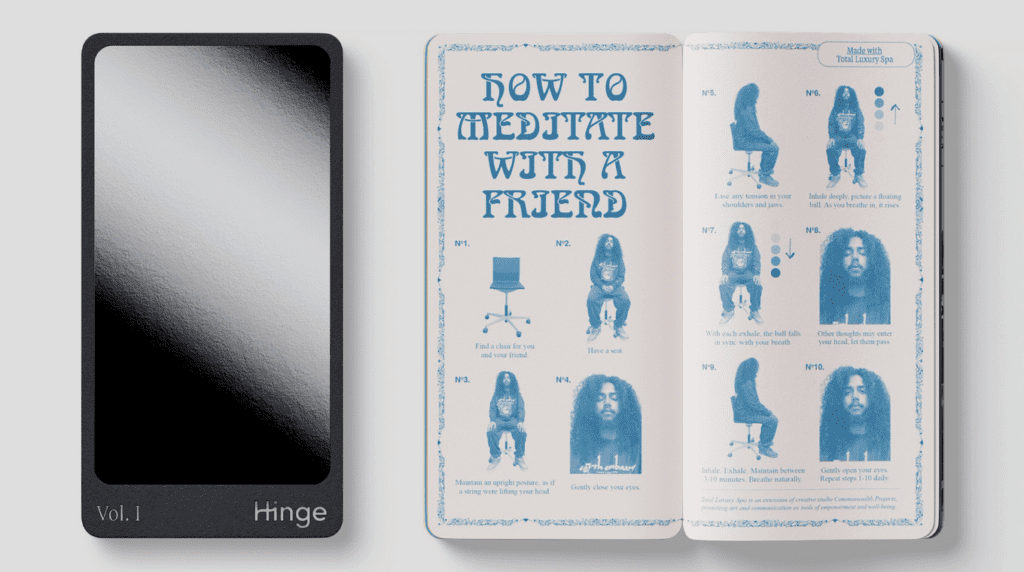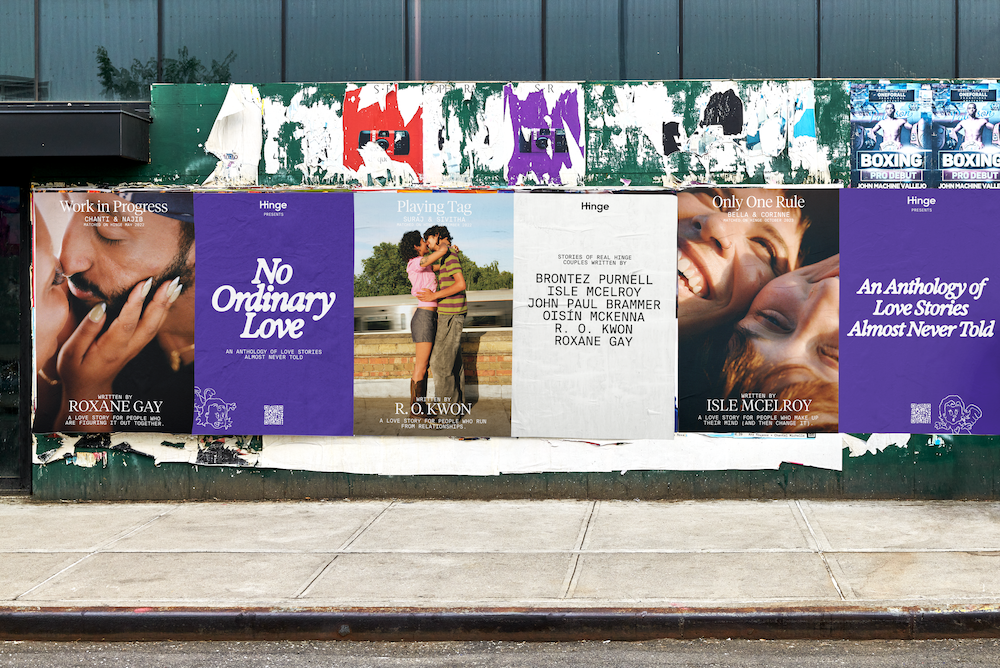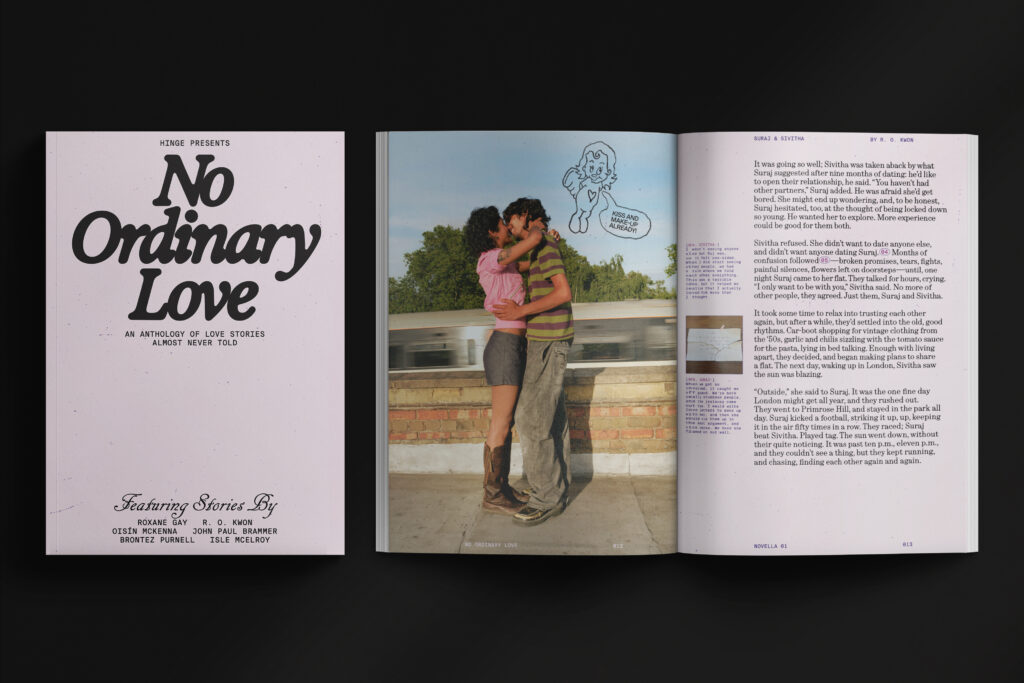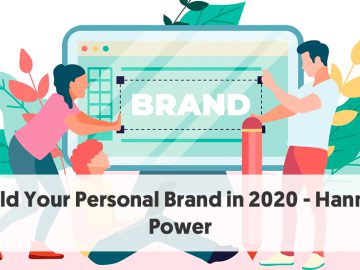Hinge’s slightly counterintuitive tagline—”The Dating App Designed to Be Deleted”—dares users to stop using its product.
“Everything we do at Hinge is focused on getting people off the app and into great dates,” says Jackie Jantos, Chief Marketing Officer at Hinge. “We do this through the product experience, which is built to help focus you into conversations and ultimately get out on that first date.”
The idea that the app should facilitate a match rather than stick around long-term is based on the user’s end goal: to enter the real world of in-person relationships and leave swiping behind. This concept shines through all of its marketing programs, Jantos says, which are “focused on giving tips and giving advice… We think about them as long-term programs versus specific discreet campaigns.”
Hinge’s most recent campaign, titled “No Ordinary Love,” is an anthology of love stories written by six contemporary literary figures and produced as a physical artifact: an 80-page zine. Each vignette is an interpretation of modern romance—free of idyllic, fairy-tale beginnings—experienced by a real-life couple who met on Hinge.
“The audience for this particular work is the next generation of daters,” Jantos says. “There is this notion that there is a perfect way to begin a relationship. For us, reimagining this and bringing more realness to “we met on Hinge” stories was important to giving dimension to what relationships can look like at the very beginning—with all of their twists and turns.”
We spoke with Jantos about the campaign’s marketing goals, the return of romance literature and rise of #BookTok, working with creators on social, and must-haves when marketing to Gen Z audiences.
Chief Marketer: What was the inspiration behind this campaign?
 Jackie Jantos, Chief Marketer Officer at Hinge
Jackie Jantos, Chief Marketer Officer at Hinge
Jackie Jantos, Chief Marketing Officer at Hinge: “No Ordinary Love” is an anthology of love stories written by six authors, sharing the six real stories of couples who met on Hinge. We have been telling real stories of people who met on Hinge for a long time. We recently told some of these through our Hinge Afterlife brand program, which [followed] the demise of Hingie, the app’s mascot. We also do a lot of work in the creator and social space with partners like Meet Cute NYC to tell stories of how people met. This is another iteration of that.
CM: Going with a printed zine as your marketing material is an interesting choice. What insight or research informed that decision?
JJ: Everything we do is connected to what we’re learning from users and our Gen Z-oriented research partners. The audience that we’ve been focusing on serving for this particular work is the next generation of daters. There is this notion that there is a perfect way to begin a relationship. For us, reimagining this and bringing more realness to “we met on Hinge” stories was important to giving dimension to what relationships can look like at the very beginning—with all of their twists and turns.
The insight from a media perspective is around the fact that romance literature is coming back—and has been back for a while. If you look through what’s happening on TikTok, and BookTok in particular, romance stories have been on the rise. We wanted to celebrate that through a physical artifact that people could read in the same way that they’re engaging in romance literature.
Finally, we work with creators in dynamic ways at Hinge. We don’t use our own social handles. So if you were to look up @Hinge on Instagram, you would find a single tile that says “The Dating App Designed to Be Deleted.” All of our storytelling in social spaces where our audience is comes through creators that we have relationships with. And we’re always looking for new and interesting ways to work with people. This is our first time working with writers in this way. We wanted to honor the stories they were writing and we also wanted to print them out in a physical zine to do that well.
CM: How does this campaign fit within Hinge’s broader brand strategy and marketing efforts?
JJ: First, it’s more interesting storytelling around people who have met on Hinge. Telling those stories in unique ways helps people understand that there’s no perfect way to start a relationship, particularly for a young audience that hasn’t had as much time spent in person with one another. Relationships don’t always start off with this perfect story, fairytale beginning, as culture often presents. Being real is really important to us.
The second thing is we do a lot of work within our marketing strategy and more broadly within our social impact strategy of encouraging young people to get together in person—whether that’s encouraging people off the app into a real date, like this work shows, or our social impact work encouraging people to spend just “One More Hour” in person. We’ve been creating physical artifacts for a while now to encourage in-person connection. It makes sense for us to both showcase what it might look like to meet someone in these “perfectly imperfect” ways and also to encourage people to meet in person—in romantic ways and otherwise—to start practicing some of those skills.
CM: What other physical artifacts have you created?
JJ: One great example is the Hinge phone book we released earlier this year. That’s part of our One More Hour program. It looks like a physical phone book, but in actuality it’s a hundred pages of inspiring, fun, silly, playful things to do to get off your actual phone and start doing things in the real world with one another. It’s a fun physical piece that we handed out and also used as inspiration for outdoor posters.
 Hinge’s “phone book,” disguised as a cell phone, contains pages of activity ideas for in-person meet-ups.
Hinge’s “phone book,” disguised as a cell phone, contains pages of activity ideas for in-person meet-ups.
CM: What will make this latest particular campaign a success?
JJ: It’s about people understanding that there is no perfect start to a relationship, and an openness to exploring the different ways of trying to meet off the app and in person. That’s a really big indicator of success for us.
Understanding and engaging and interacting with the content itself is also a measure of success. We want people to see and read these stories from these writers and experience a range of different ways into relationships, whether that’s starting on a different page, meeting and exploring each other over time, or not necessarily knowing how to enter a relationship but giving it your best. Encouraging people to keep an open mind is what we’re looking for, however that shows up on their own journey of dating.
CM: How do you end up finding couples who were successful matches on the app?
JJ: We hear from them directly. We receive a number of things—like wedding invitations to the office—every day. There is no better organic marketing than couples who meet on Hinge. And when people do meet on Hinge and that turns into an ongoing relationship, they talk very proactively about how they met.
Our social partner, Meet Cutes NYC, is essentially a social handle run by a group of people who do person-on-the-street-style interviews, walking straight up to couples and asking them how they met. We observed that a good number of people who met in New York had met on Hinge. So when you look at any of these stories that are just naturally occurring in the social sphere, you’ll find a lot of successful couples who have found themselves through our app.
CM: When online dating first began, it was almost taboo to say you met online—and now it appears people are sharing it with pride across digital channels.
JJ: Absolutely. We have a “We Met” survey for when they’re leaving, and we’re the only app to do that. So we also learn about people who have met that way. But more and more, we are seeing these stories pop in spaces like TikTok, where people are, to your point, showing us how they met or sharing more about their relationship and its start point.
Regarding the insight around reimagining how romance has been portrayed to us over the decades and celebrating how your romance may have started in a very different way, I think this generation is really yearning for honesty and realness. That’s also why it’s fun to celebrate starting a relationship on a dating app and maybe starting with a partner who you were matched with a year ago, and then rematched one year later. It is quite imperfect, but it’s really wonderful to share and broaden the public imagination of how a relationship might start.

CM: Beyond the scope of this particular campaign, what are your biggest marketing challenges at Hinge?
JJ: We are the fastest growing dating app and very focused on engaging and serving Gen Z audiences. In order to do that, we have to be incredibly astute in understanding what their needs are. One of the things that we do is live within a principal we call “with, not for.” This is about designing programs and designing product with audiences having a seat at the table, to help us do that in the most credible way.
The eternal challenge is being relevant and genuinely being useful to the audience we’re trying to serve. So you’ll notice in all of our marketing spaces, if we are not being highly entertaining, we are aiming to be incredibly useful, whether it’s dating tips that we share through date reports or not-so-frequently-asked questions, which is a platform designed to help daters better understand what we’re observing and learning from the community itself, such as the best way to date and meet, and answer questions that haven’t been answered in public discourse.
We’re trying to be really useful to this generation in helping serve their needs. And I think that is the challenge for any brand that is trying to engage with Gen Z. Because if you’re not, they will call you out on that very, very quickly.
CM: Given that you’re not the only dating app out there, what’s your strategy to set yourself apart from the competition?
JJ: The experience of the app itself differentiates us from the category. We are very focused on that goal of getting people off the app into dates. We don’t focus on engagement. We don’t have advertising on our platform. We do focus on how we’re serving people through the experience of the app. We’re encouraging them to offer more about themselves through formats like prompts, so that we can help them find a more relevant partner that meets their needs, and we’re encouraging them to focus in on their conversation. We released a feature recently, “Your Turn Limits,” which essentially allows people to maintain or reduce the number of open conversations that they’re having at any given time. It imposes actual limits on conversations to help people stay focused and close out conversations that they’re not necessarily as interested in.
And then I would come back to this idea of being useful to daters through all of the channels that we can leverage, be it out-of-home or social or zines, and being eternally creative about how we’re reaching out and encouraging people to think about things—like what a relationship could look like for them, how to maintain an open mind, how to focus on the quality of the relationship you’re looking for versus the quantity of matches… I think whenever you have a product experience that is unique within the category, it gives marketing a lot of inspiration to make sure that all the programs you’re creating are doing justice to the product experience itself.
CM: Lastly, there are many young people who are rejecting dating apps and opting to meet people in other ways. As an example, joining running clubs for dates is a trend on social right now. How do you think about remaining competitive when it comes to in-real-life activities?
JJ: I am inspired by and influenced by the work that we’re doing in the social impact space. If you look at this next generation, they are spending far less time in person than every generation before them. And that’s primarily because of technology, but it’s also because they spent their formative high school and college years in a lockdown. So I don’t see any of these other ways to meet in person and start a relationship, be it a friendship or a romantic relationship, as competition. I see it as being in service of an audience that needs to better learn through spending time in person with one another.
One of the realities that our social impact work is addressing is the fact that the Surgeon General has called us experiencing a loneliness an epidemic. And that is disproportionately impacting young people who aren’t spending enough time in person, with the decline of third spaces and a real reduction in having the confidence to get out and spend time with other people. Through One More Hour, we’re investing in young people, organizing social clubs and groups. This is a big part of our programming as well.
So anything that’s encouraging people to spend time in person, we are all for that. Gen Z brands trying to engage this audience also need to be thinking about the acute sense of loneliness and the social isolation they’re feeling, whether they’re in the space of creating real life experiences or encouraging connection. It’s a huge part of their world that needs to be addressed and supported right now.



